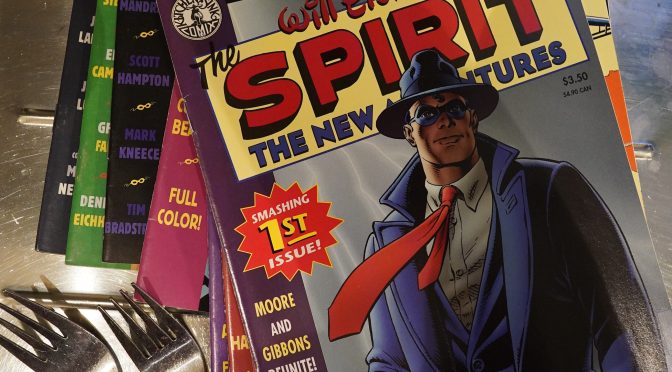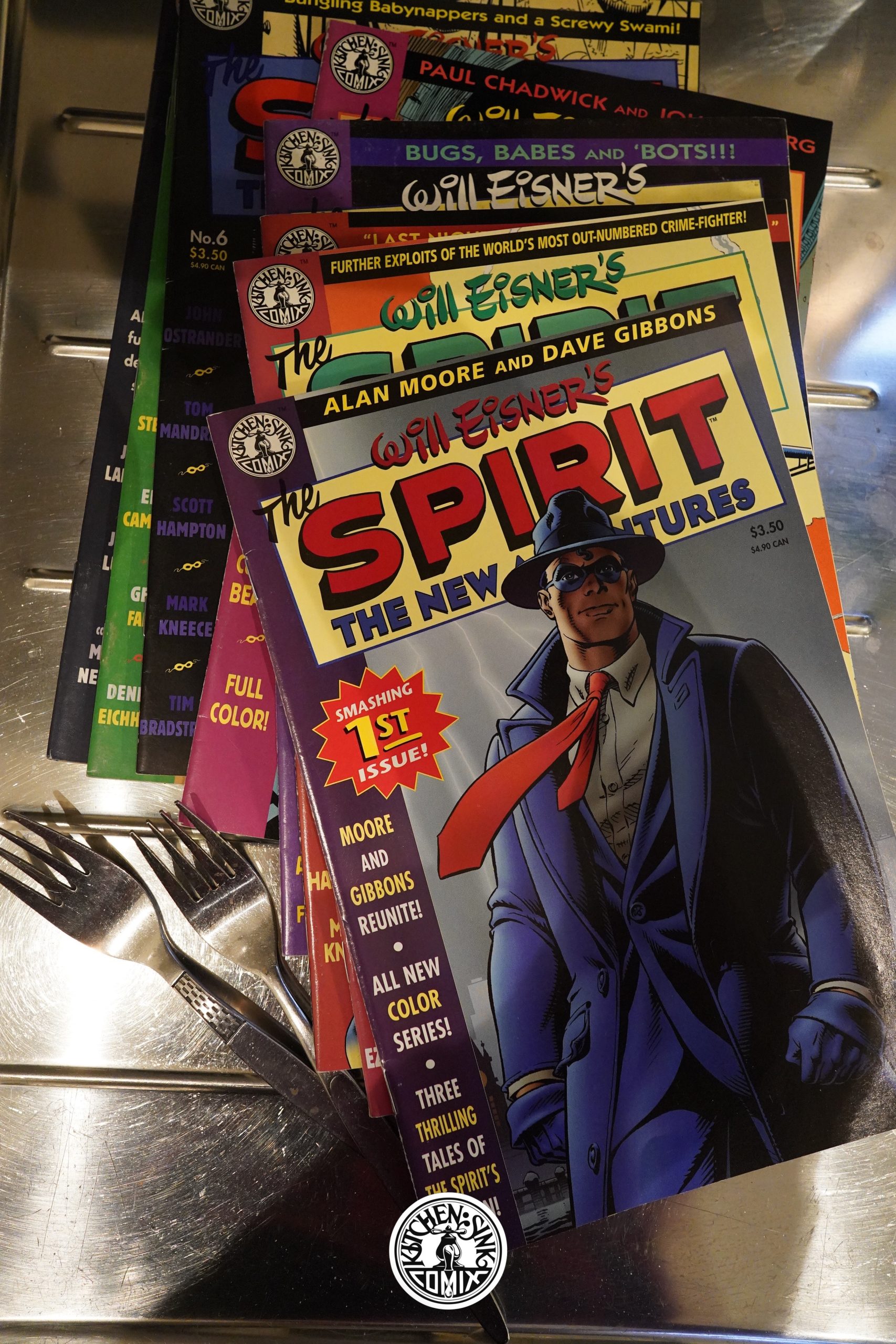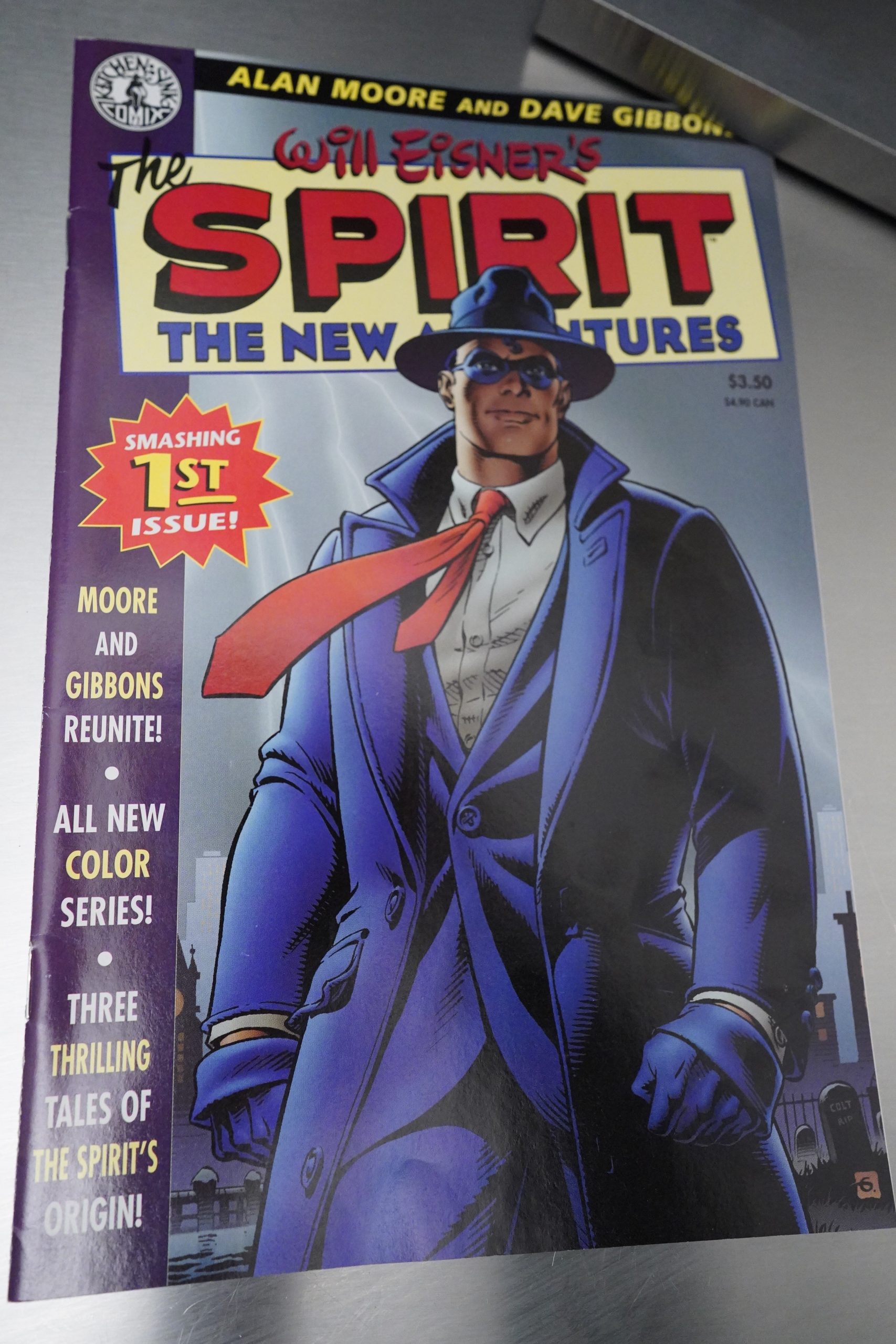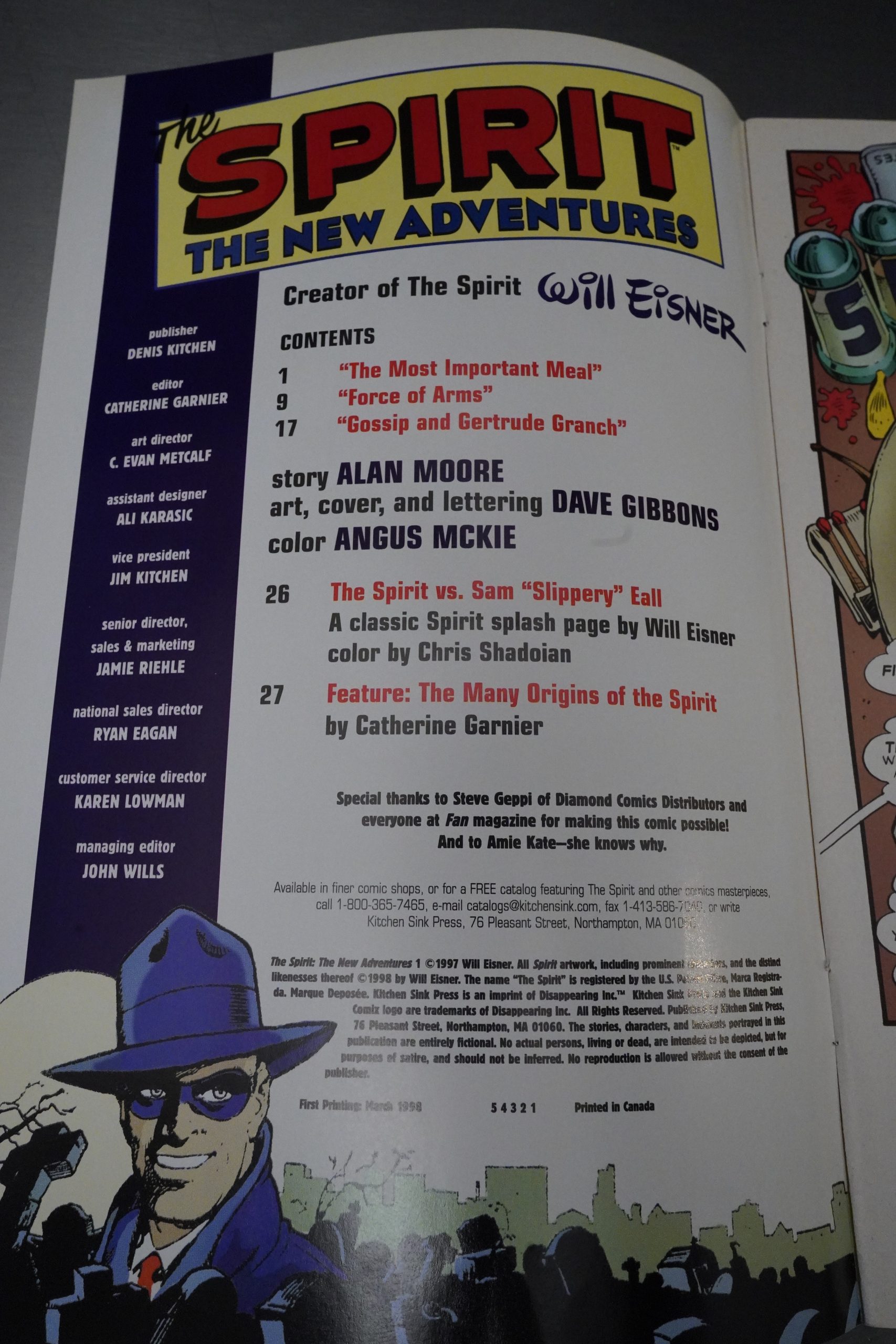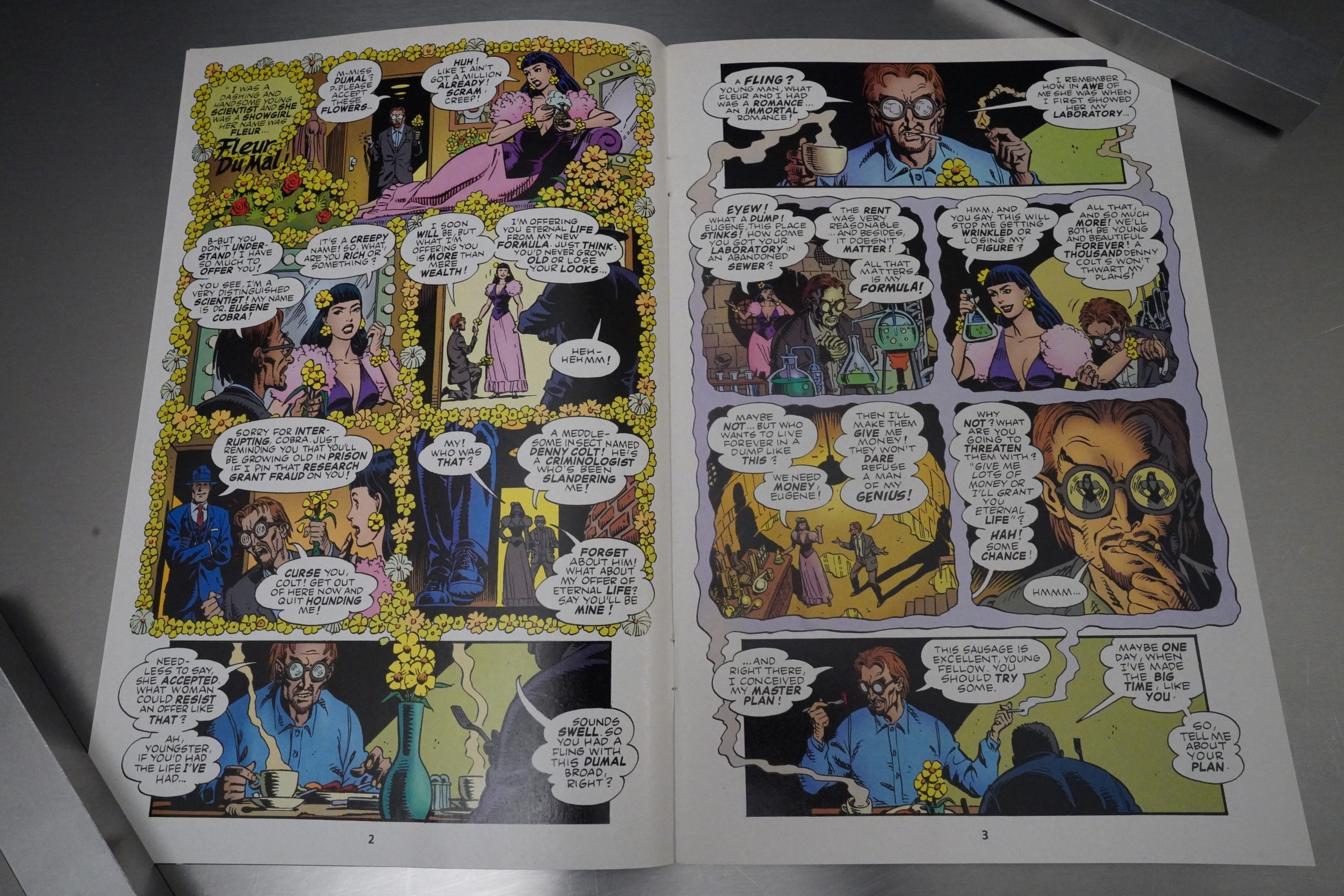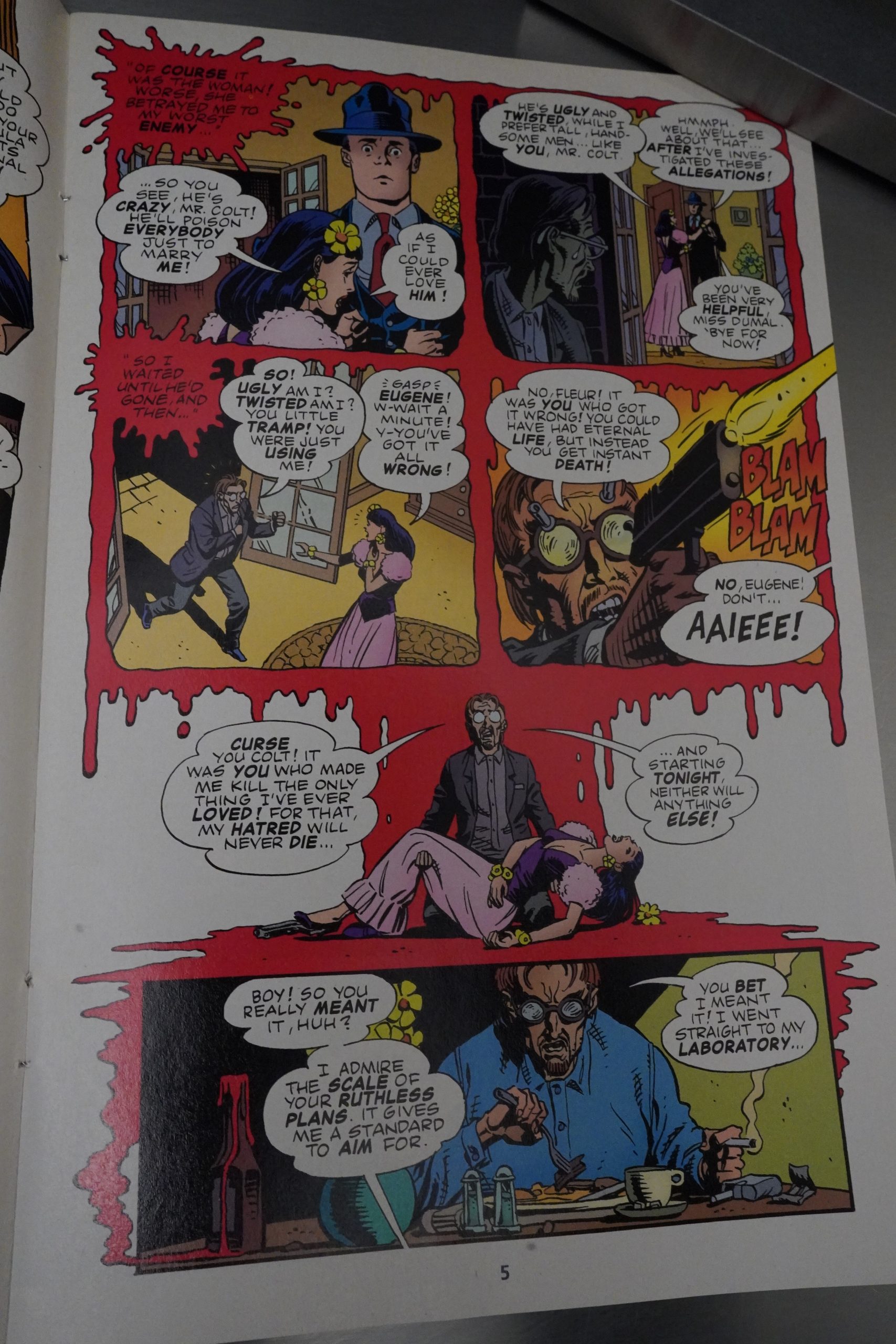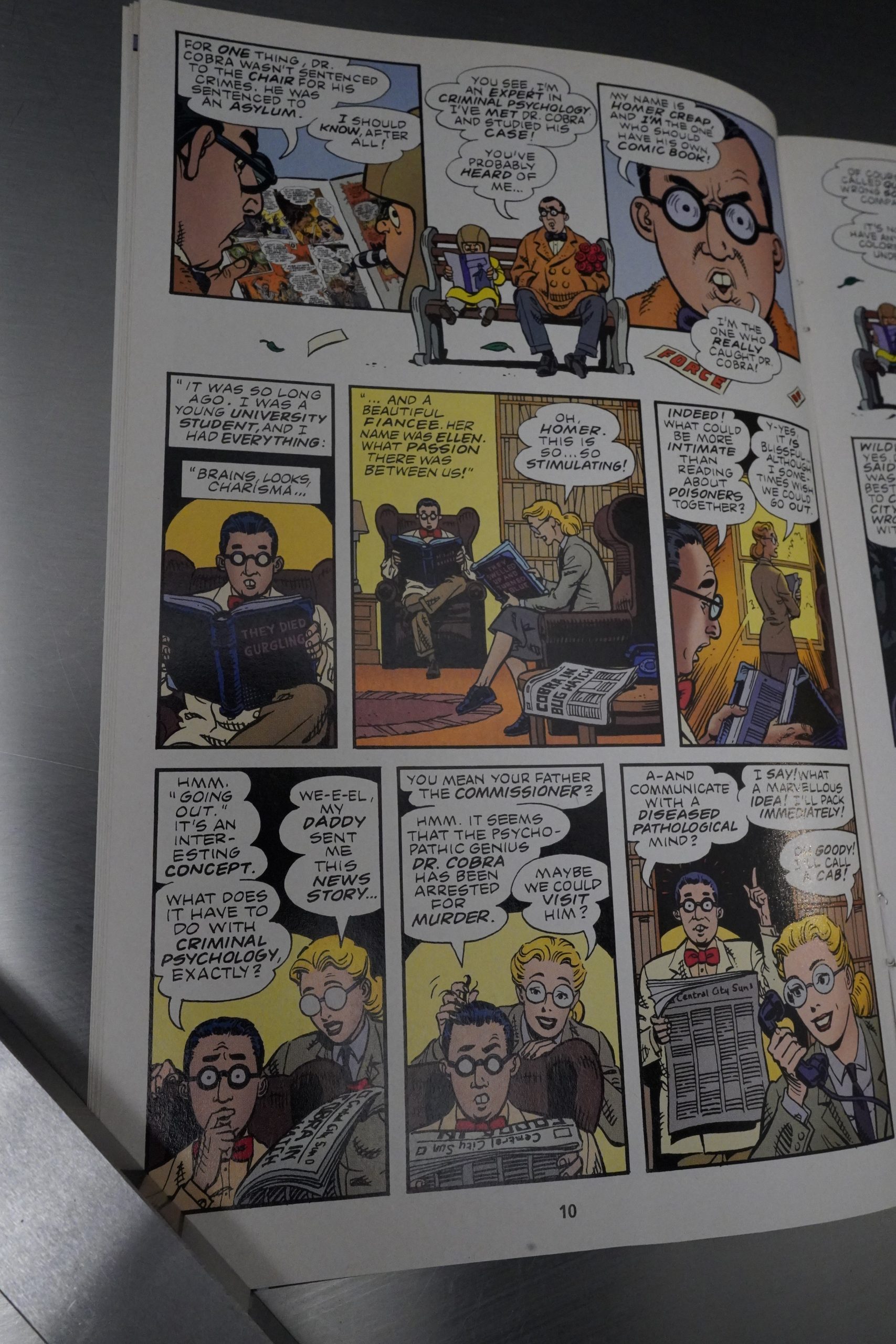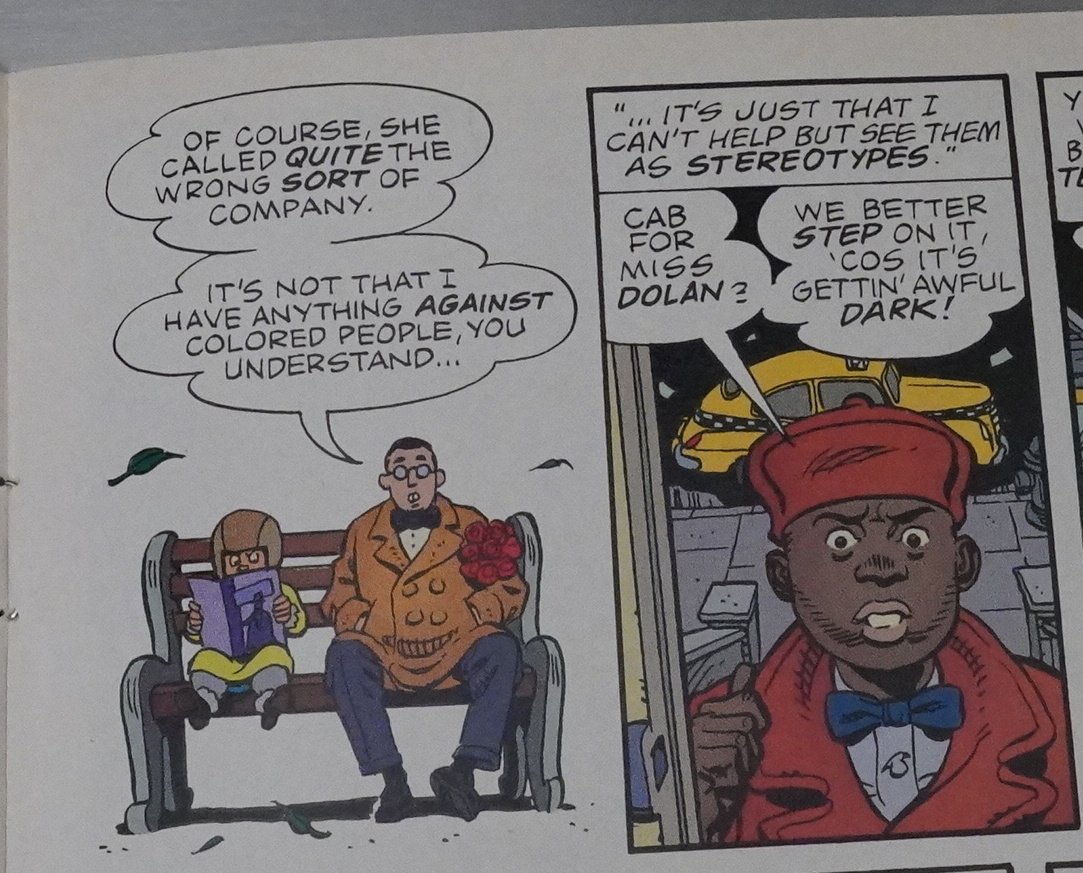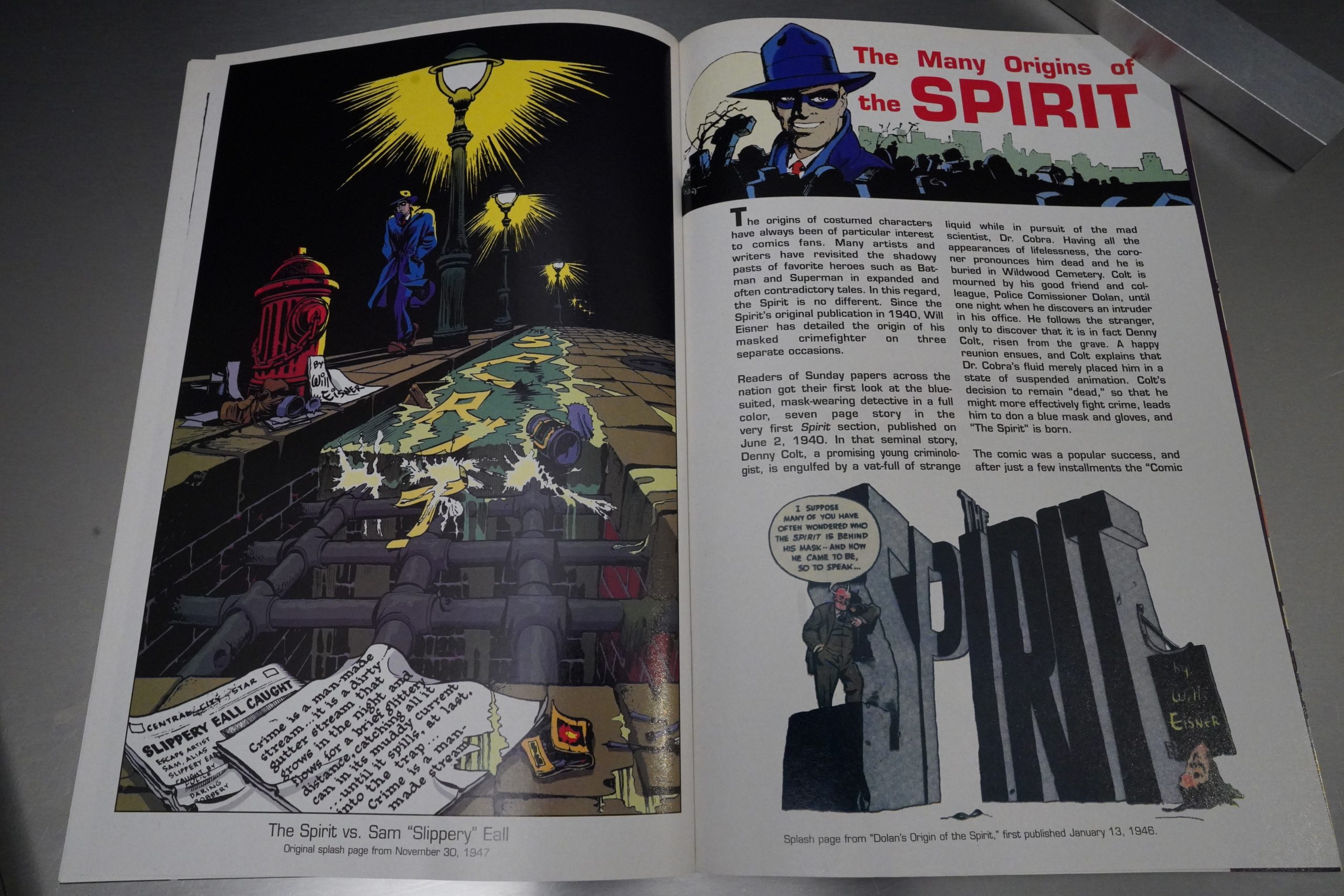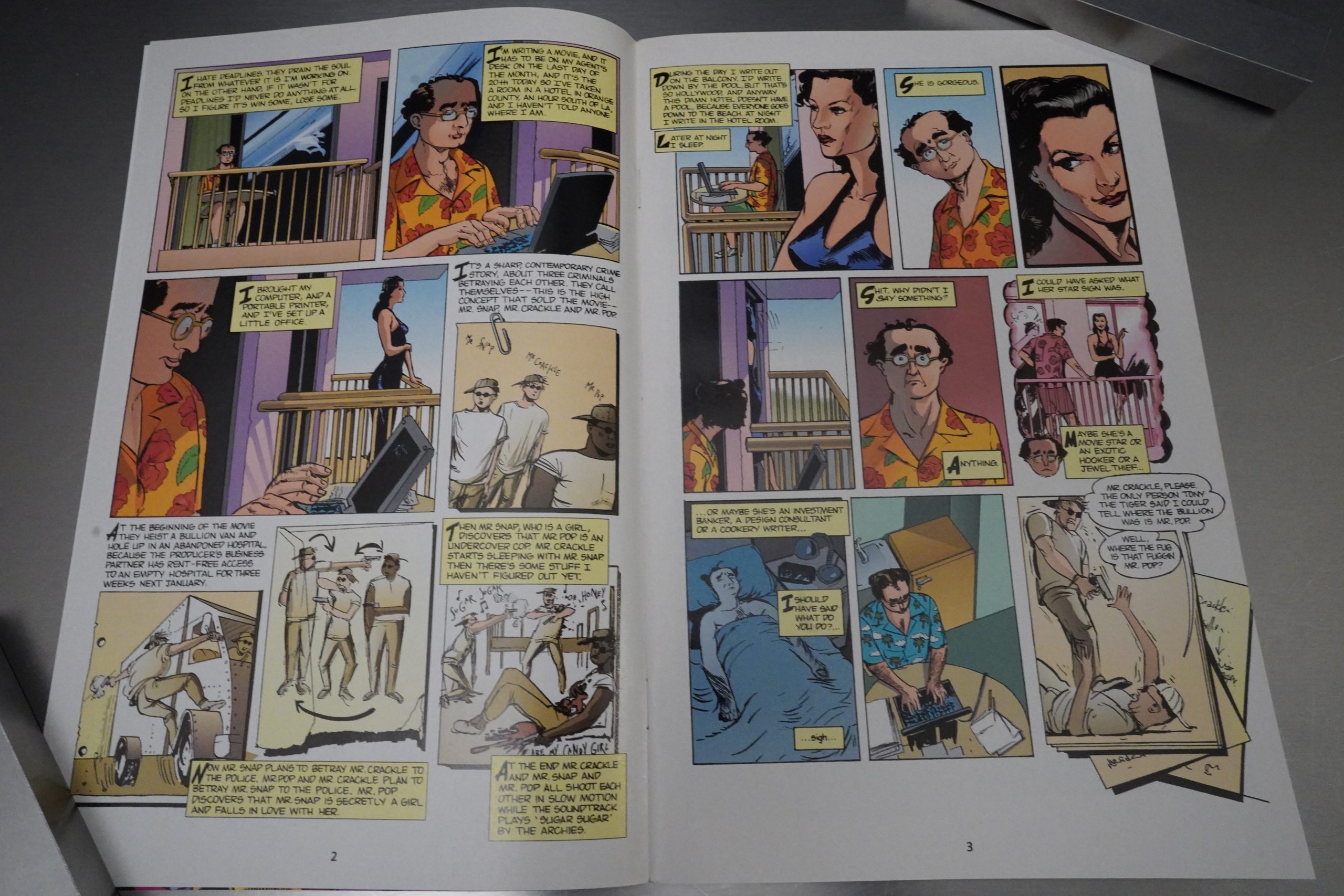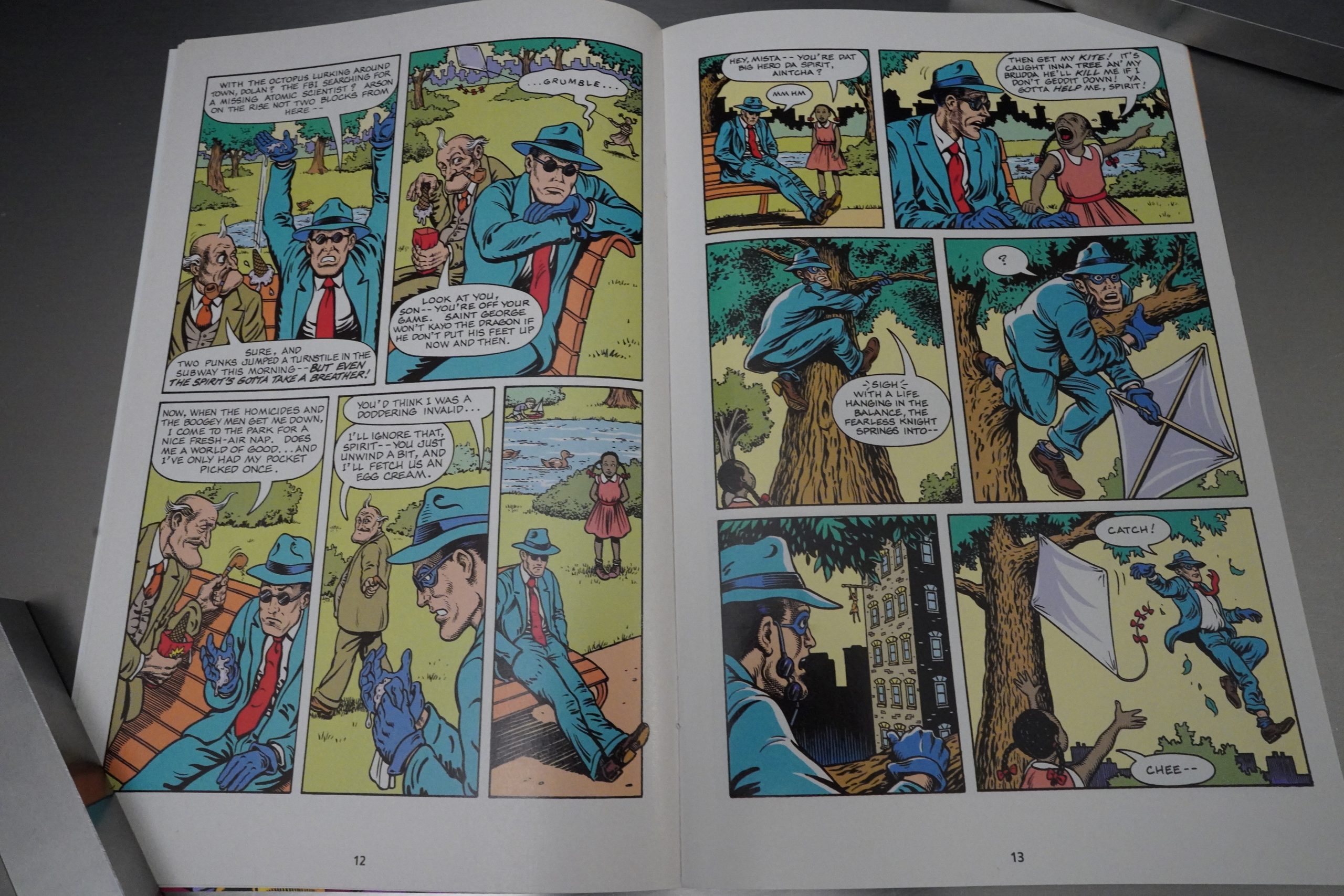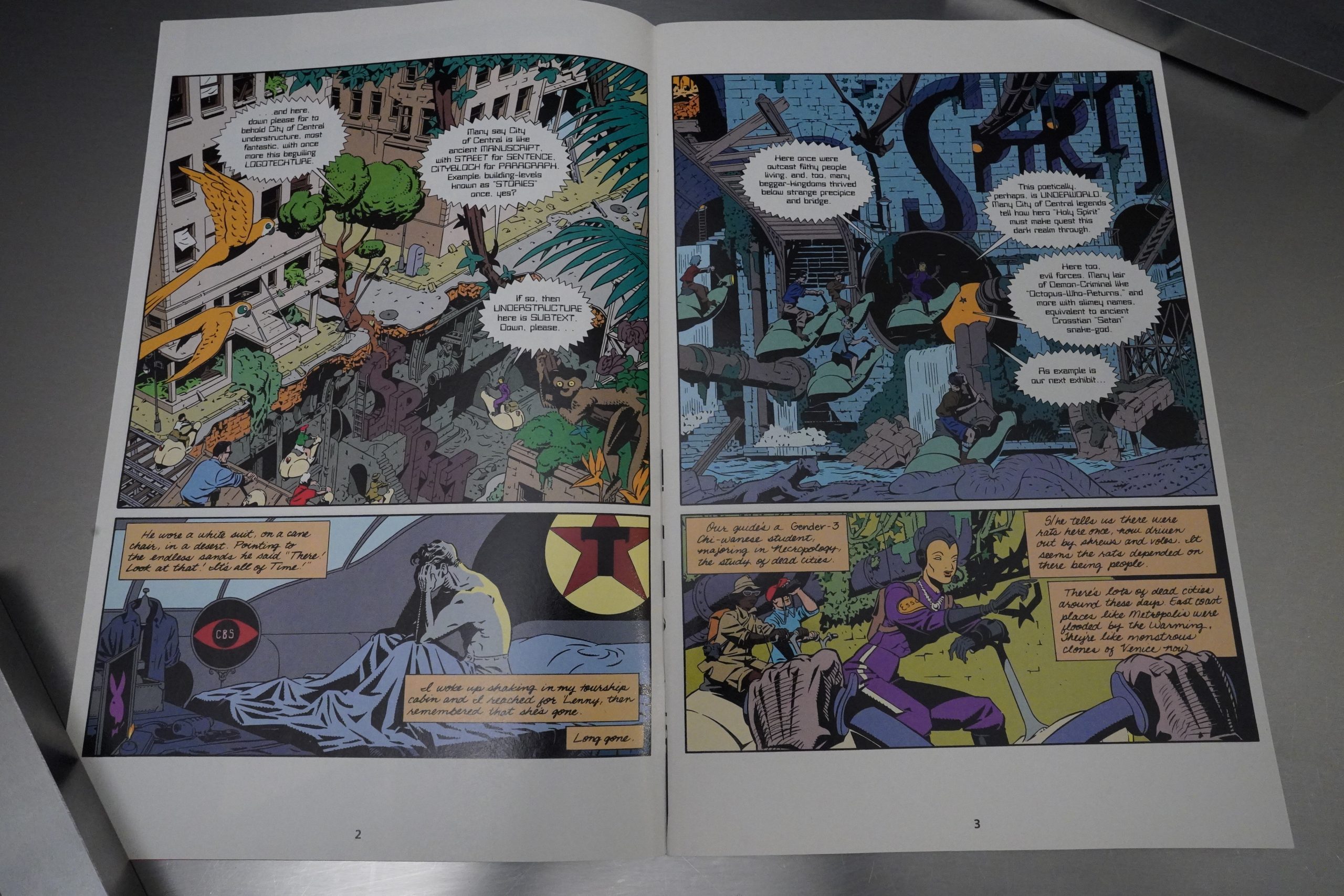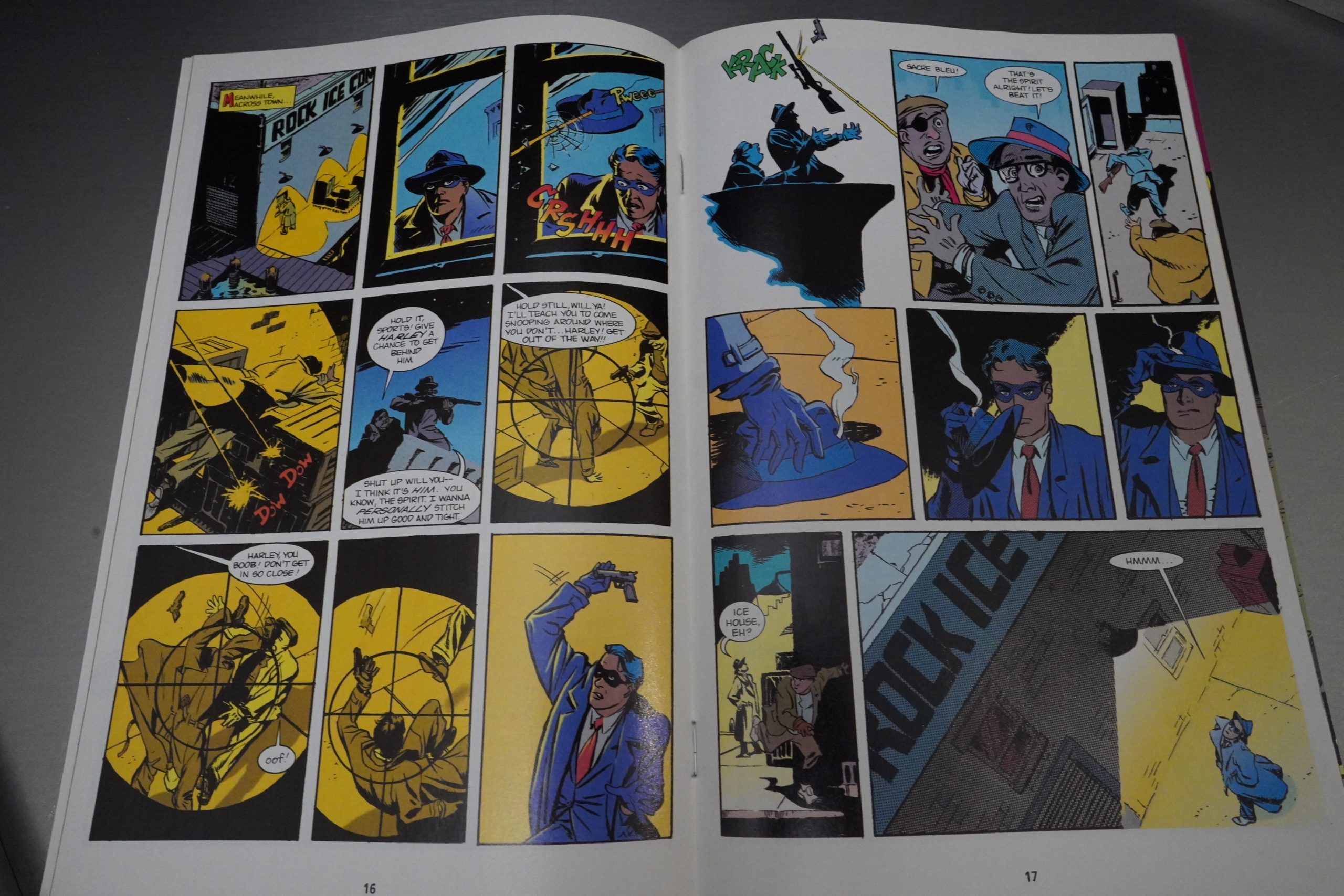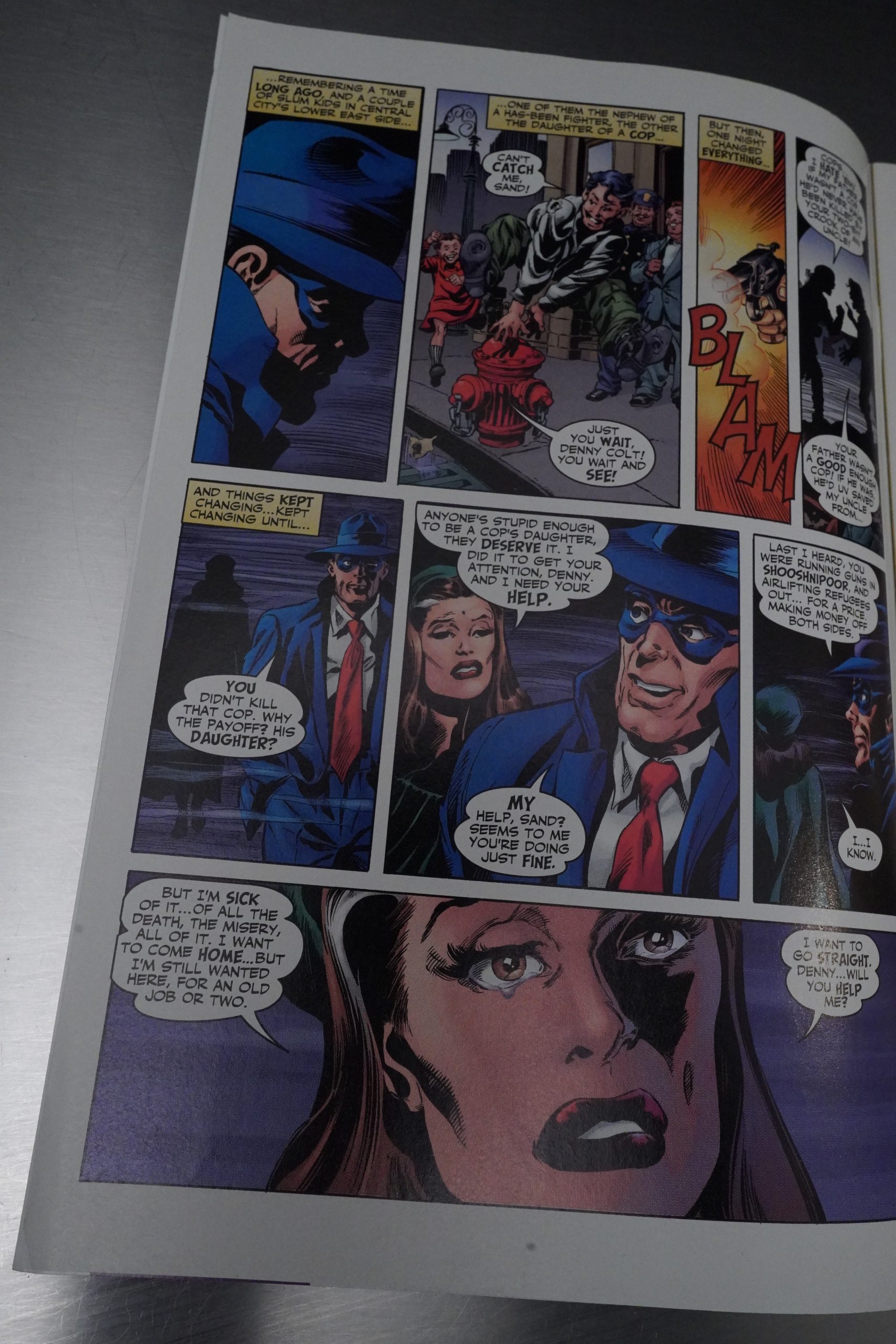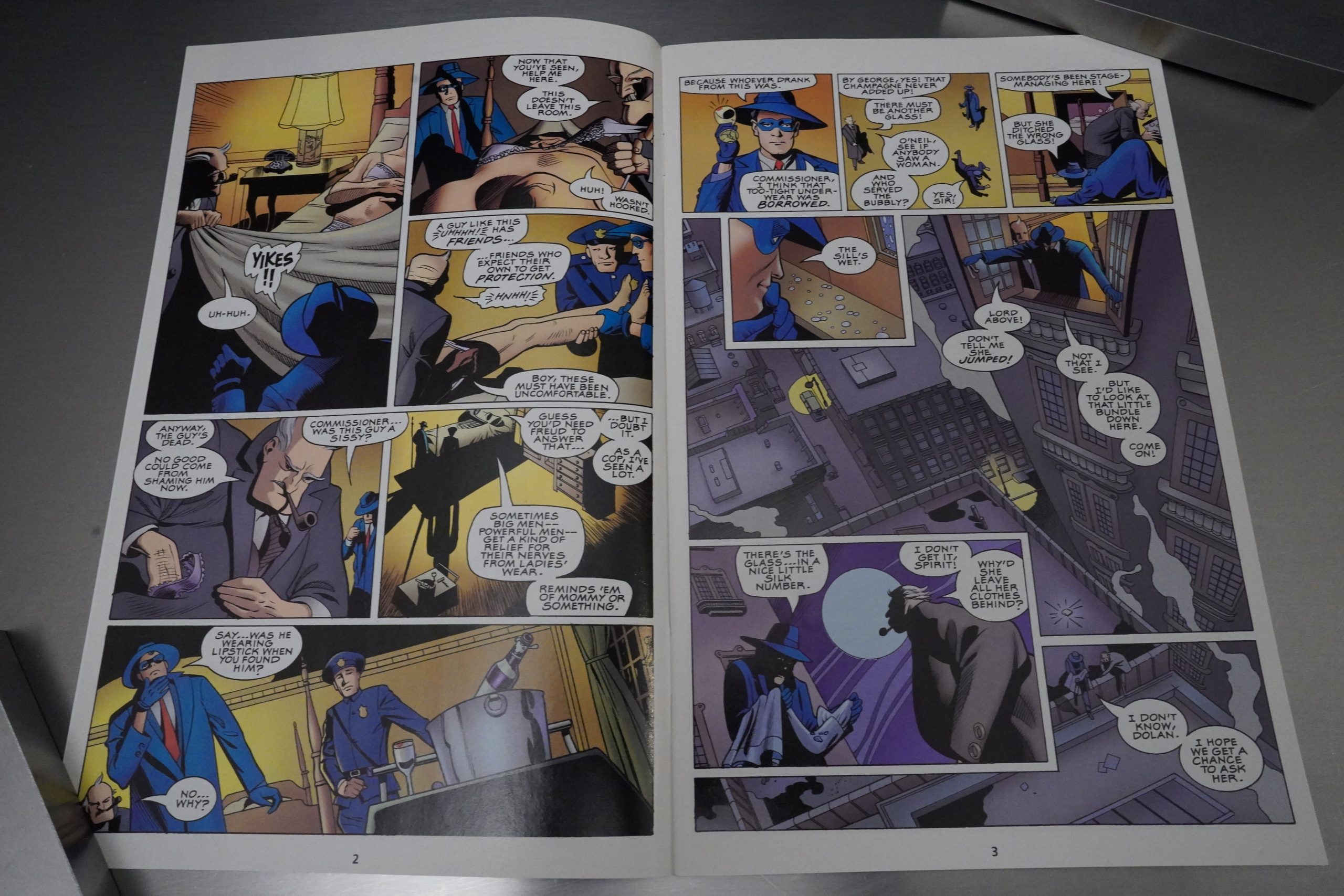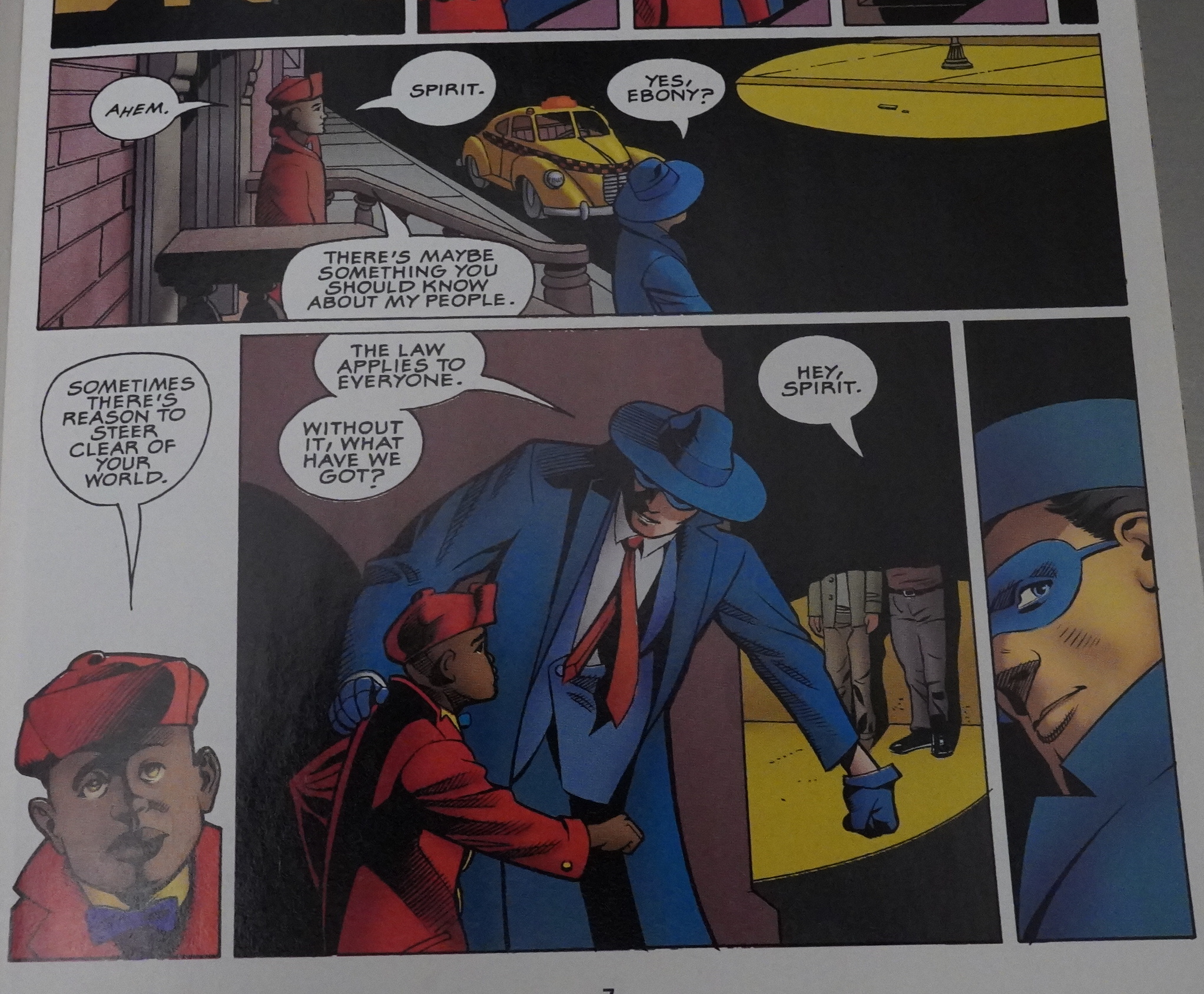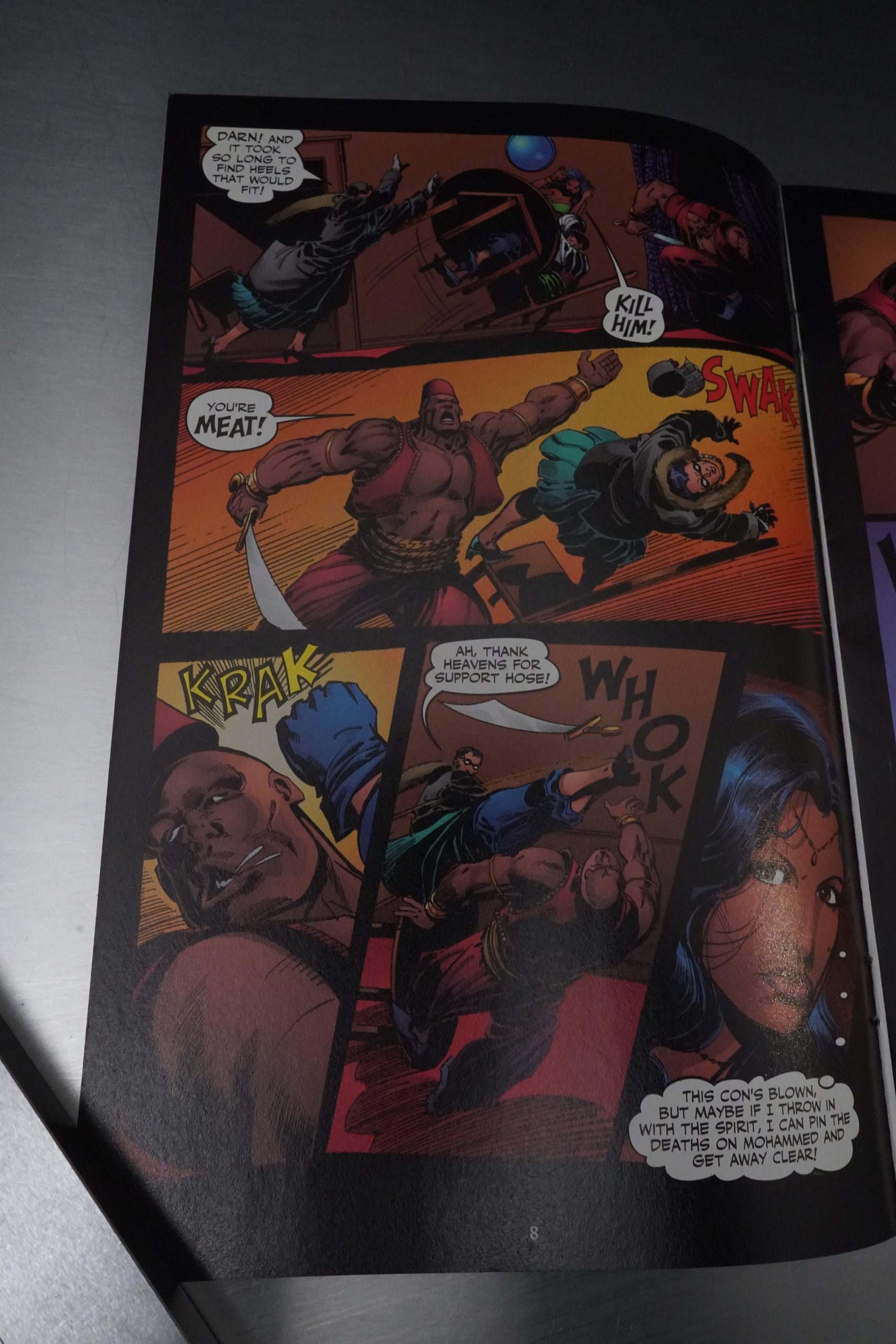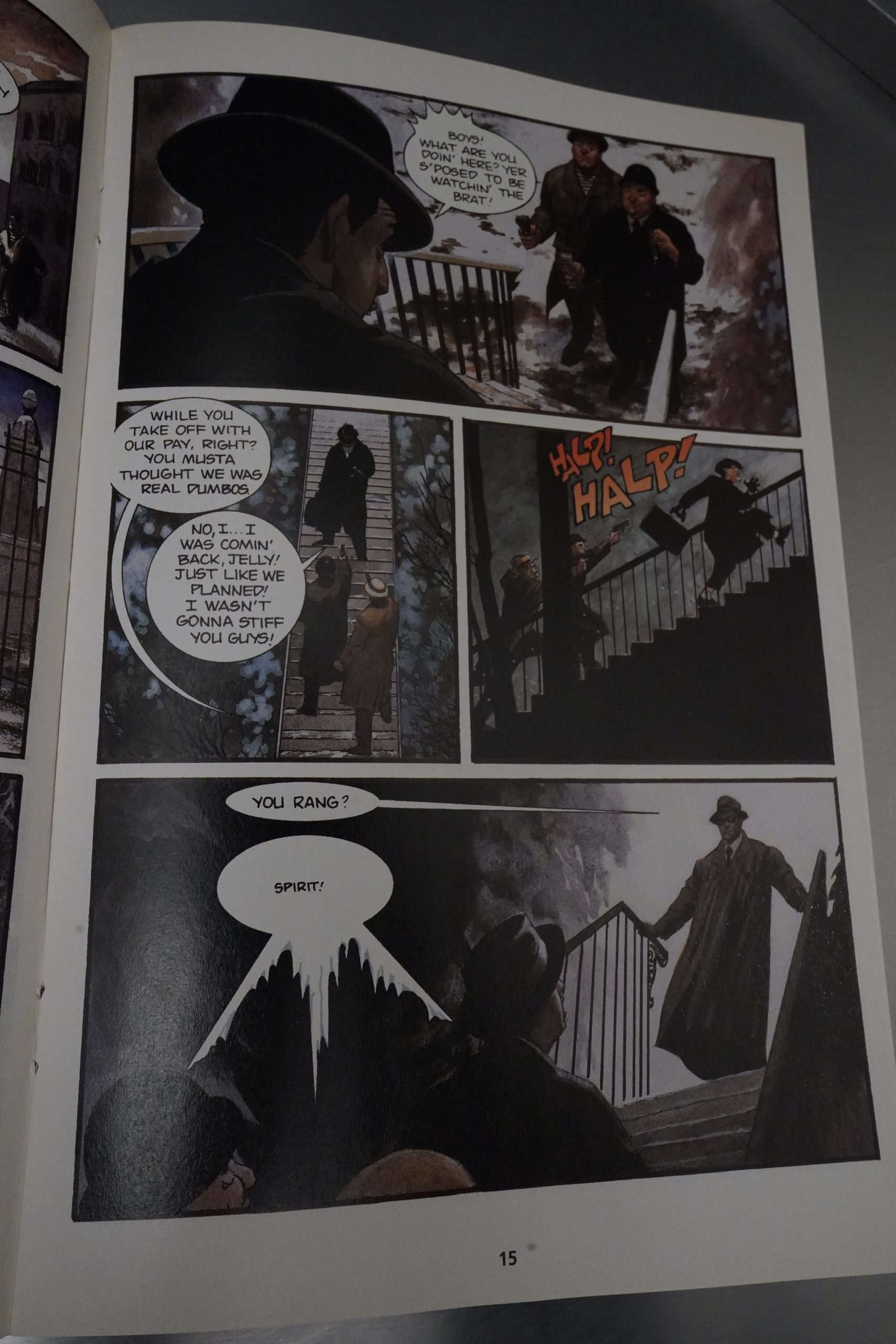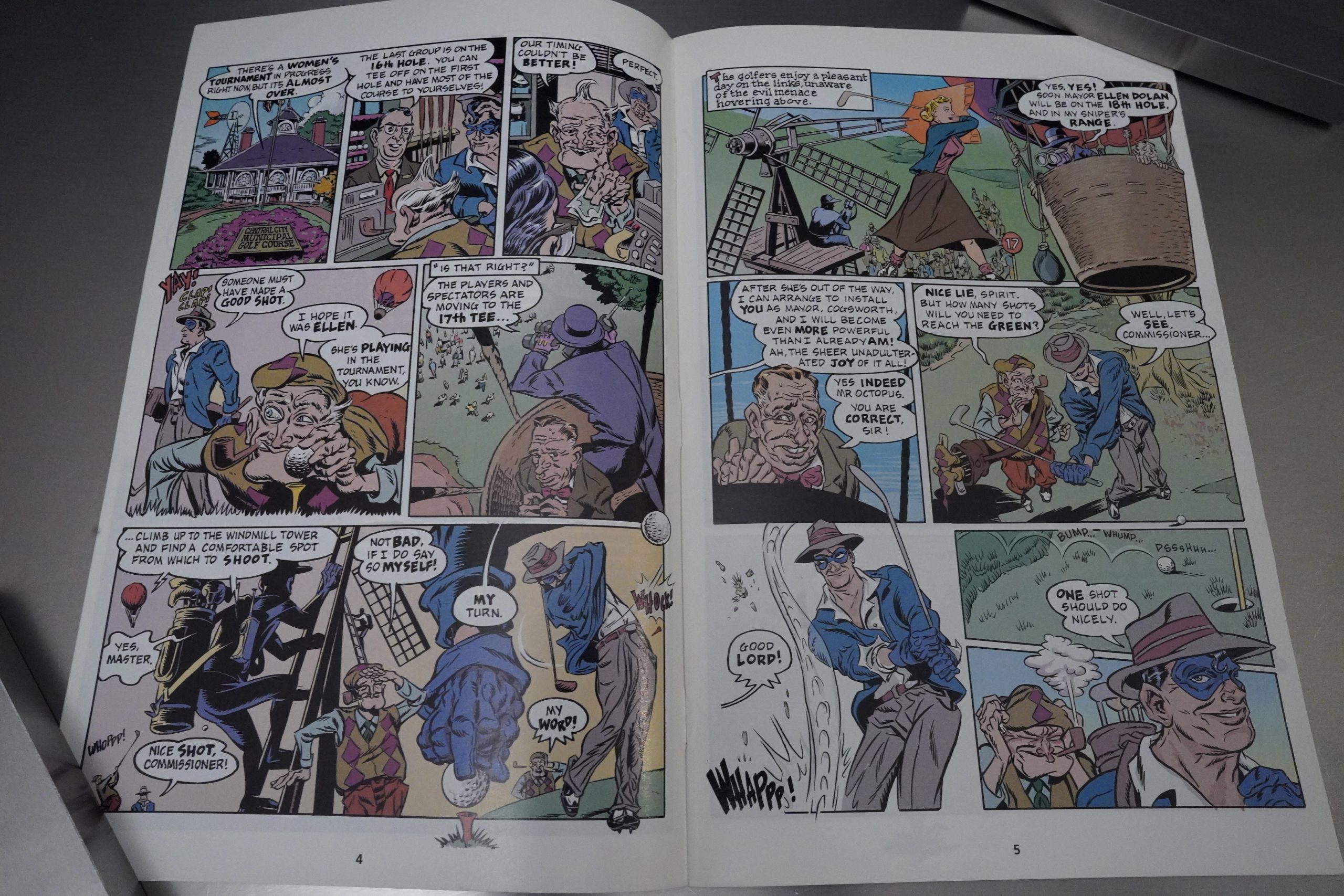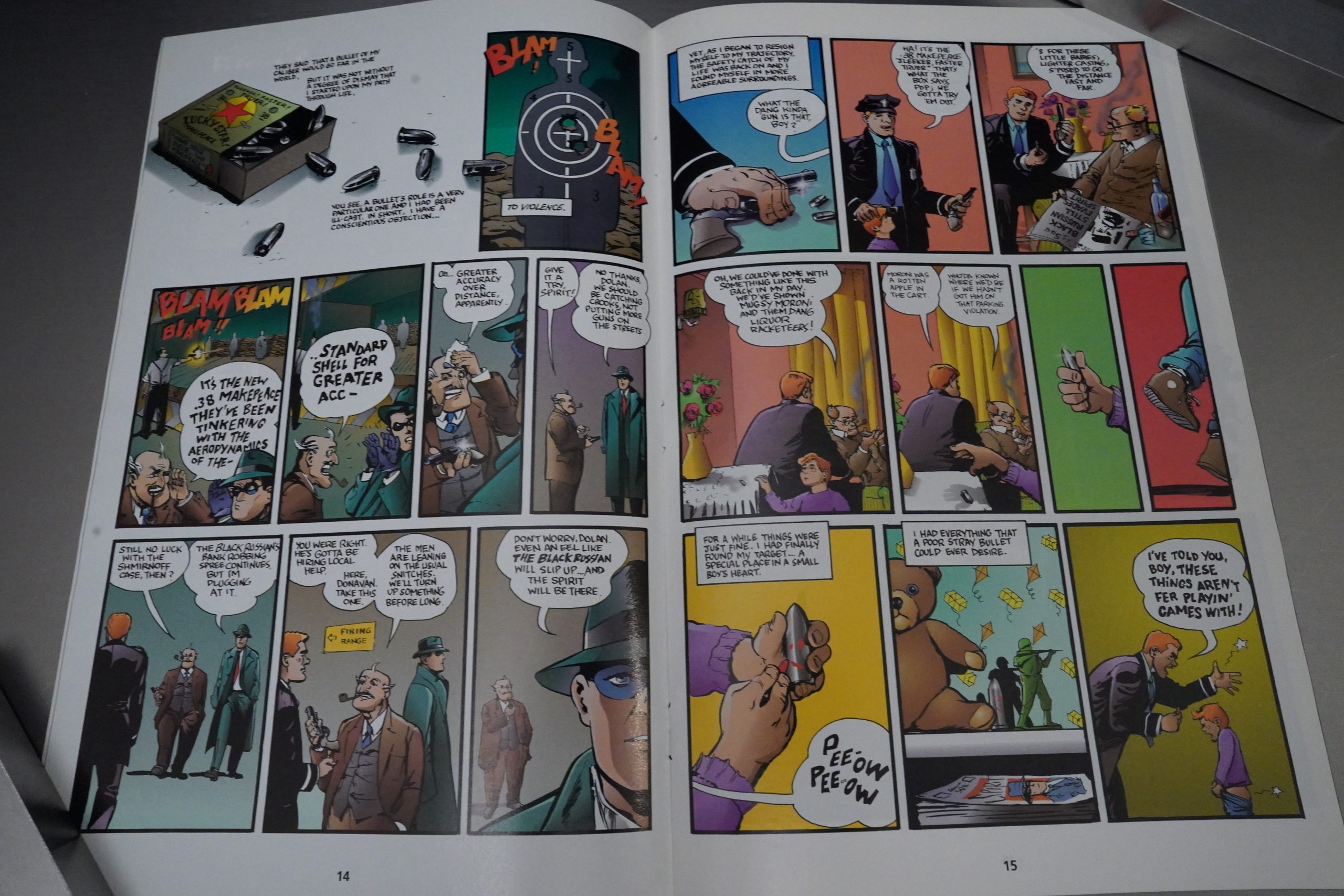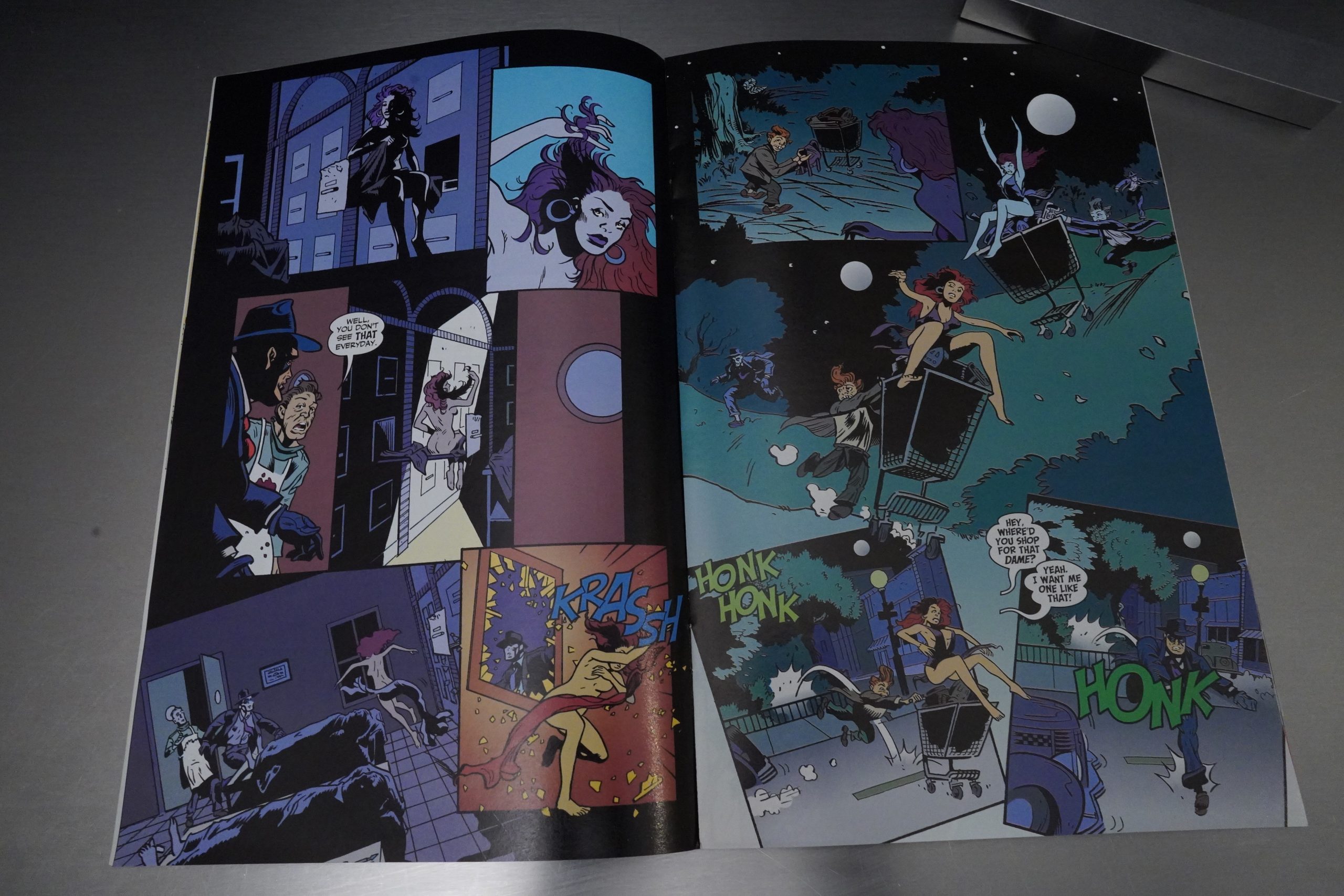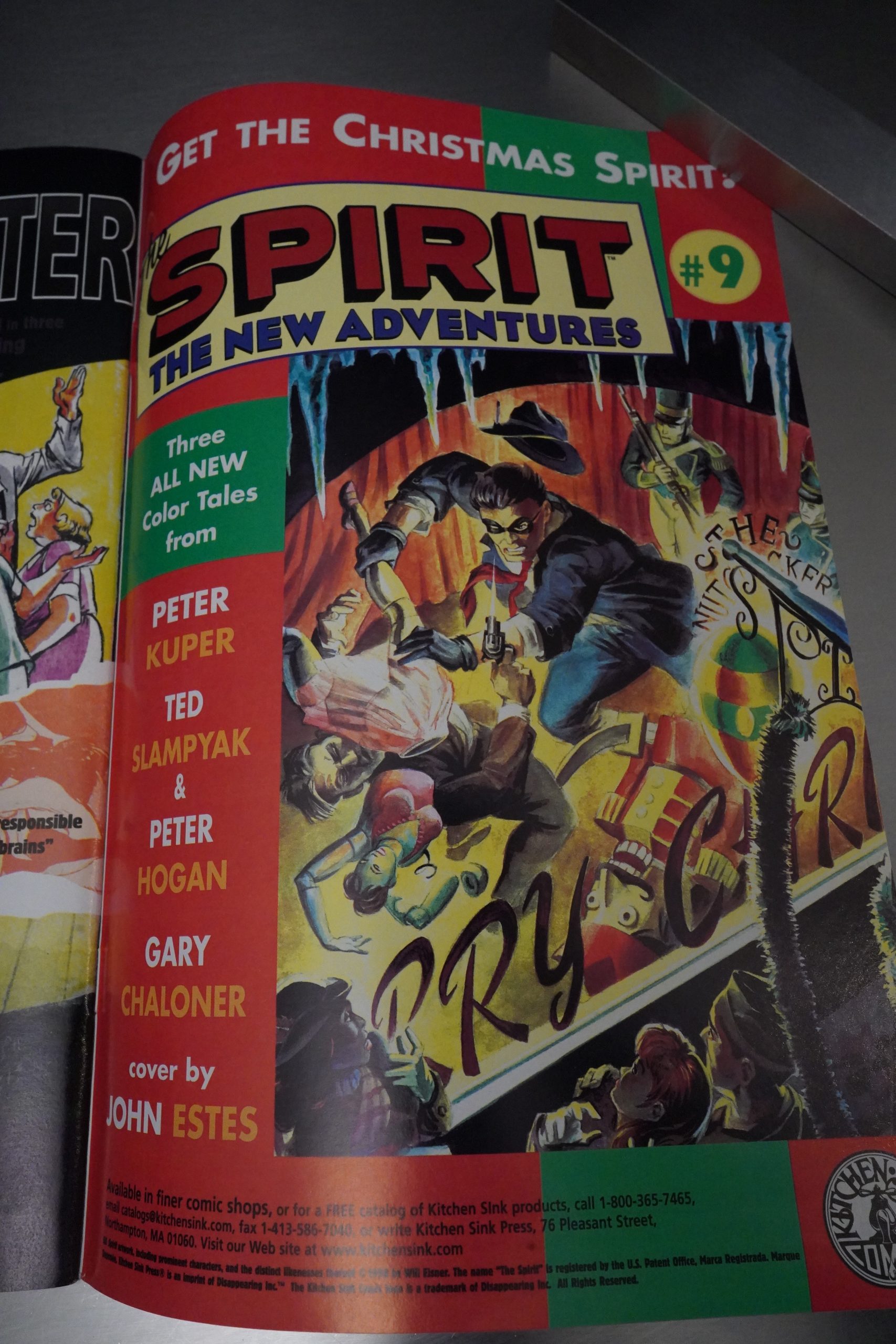The Spirit: The New Adventures (1998) #1-8 edited by Catherine Garnier
I didn’t buy this series at the time, but not because I consciously avoided it. I was just completely unaware that it existed. (During this final part of the Kitchen Sink saga, my impression is that they were getting less press and worse distribution than before…)
But even if I had know about it, I’m not sure I would have bought it? It’s not that I don’t like The Spirit, but the strip’s charm is elusive. Even Eisner’s assistants (when they took the series over) often failed pretty decisively in making satisfactory Spirit stories.
Let’s read on and see how things go…
They mention Alan Moore and Dave Gibbons twice… but also “three thrilling tales of The Spirit’s origin”. This sets my Spidey sense tingling: This sort of wording on an anthology cover usually means “three pages by the famous people we’ve mentioned, and then the rest of the pages are by people not even worth mentioning”.
Even the contents page doesn’t immediately hit you over the head with the only pertinent thing you’d want to convey to any prospective readers: The entire fucking issue is by Moore and Gibbons!
If I was the publisher here, that’s what I’d put on the cover: “THIS ENTIRE FUCKING ISSUE IS BY THE PEOPLE WHO DID WATCHMEN”.
I know, I’m such a marketing genius.
And while Gibbon’s artwork doesn’t exactly ape Eisner’s rendering, it gives much the same feel as reading an Eisner Spirit story.
Much of that’s down to the layouts, of course, which have a lot of the dynamic qualities of Eisner, but Moore is also able to “do” the Eisner voice without having it turn into parody. It’s great!
(And it wouldn’t be a Moore comic book without a woman being killed now would it.)
And also — while the cover seemed to say that we’re getting three different versions of Spirit’s origin, that’s not the case either. It’s three linked stories, or one long story divided into chapters, if you well.
Moore also gets a sly dig in at the original Spirit depiction of Ebony White.
Padding out, I mean rounding out the issue, we get some Eisner splash pages, as well as a brief text detailing some of Spirit’s history.
Anway — that’s a brilliant way to start this series. Moore and Gibbons really deliver with a story that’s both intriguing and entertaining, and avoids having the Spirit’s origin story retelling become a bore.
The superstars keep coming — the first story in the second issue is by Neil Gaiman and Eddie Campbell. They don’t try, at all, to “do” Eisner, but it’s a fun story nevertheless. It’s mostly about a Quentin Tarantino character who bemoans his life’s lack of excitement (all the while with the Spirit running around catching criminals). It’s fun, even if the ending is a bit pat.
Unfortunately, the rest of the issue is pretty meh. (Jim Vance and Dan Burr here.) They try to do normal Spirit stories, but don’t quite get the charm right.
Alan Moore returns in the third issue with Daniel Torres, and it’s (as is often the case with Moore) a very meta story, with a look from the future at Midway as a historical semi-mythological place. It’s amusing and rather touching.
If Gaiman and Moore are alternating issues, then this is gonna be a pretty good series, right?
Bo Hampton’s artwork here is good, but Mark Kneece’s story is pure piffle.
And that’s kinda how it goes for much of the rest of the series. Kurt Busiek writes perhaps the worst story of them all (illustrated by Brent Anderson), which is somewhat incoherent, doesn’t go anywhere, and just feels like the work of a writer that doesn’t quite know how to do a satisfying short story.
Which is the case with many of these stories — they’re more like vignettes, because the people making them have little experience doing a satisfying little story in eight pages.
So the natural response to that is to allow the creators to do full issues. We get one issue by Paul Chadwick (of Concrete fame) with John Nyberg.
And it’s awful.
Chadwick, of course, tries to deal with racism and stuff, but he does it so ham-handedly that it just turns ridiculous.
And the artwork… oy vey.
But it’s better than this, I guess (John Ostrander and Tom Mandrake).
And again, a beautifully illustrated story by a Hampton brother (this time Bo) is ruined by a dreary, uninteresting plot by Kneece.
Given Kitchen Sink’s Underground background, I had expected to see at least some Underground artists taking a swing at The Spirit, but the closest we get is Dennis Eichhorn and Gene Fama. It’s a satisfyingly slight little story.
Eddie Campbell, Marcus Moore and Pete Mullins do a story that’s extremely Eisner — the protagonist of the story is a bullet, and it’s told from its point of view (mostly). It’s fun. The artwork, though, is kinda minimal, and has the worst colouring in the series.
The series ends with another full story issue — by Joe Landsdale and John Lucas. The story is fun, but the execution leaves a lot to be desired.
Hey! A Peter Kuper story was planned for the ninth issue? Unfortunately, Kitchen Sink went under before that, so it didn’t happen.
This series was a lot better than I expected. I’d say about half the stories are pretty good? And the first issue is excellent.
RC Harvey writes in The Comics Journal #267, page 93:
We talked about The New Adventures
ofthe Spirit, a series that “-as due out soon
from Kitchen Sink press. The series would
feature new Spirit stories written and drawn
by others: Eisner would have very little to
do with the series. He deliberately kept his
hands off, he told me. He saw scripts and
pages in rough form, but he felt the new
creative teams — all stellar creators in the
field — should be permitted to do what they
want to do.
“Give them creative freedom,” he said.
“With people like Alan Moore and Neil
Gaiman, I don’t have any intention Of alter-
ing their stories. Yes, I monitor the project
to make sure the stories aren’t being warped
into something strange, like Batman. And
I’m very pleased with what I’ve seen so far.”
Denis Kitchen was responsible for this
revival of The Spirit, too. He kept asking
Eisner if he ever thought of doing any new
Spirit stories.
“I said, ‘Yeah, I do — but then I lie
down until the feeling goes away,'” Will
Besides, he told Kitchen, he was deep
into other projects. He wanted to do other
kinds of stories with more serious treatment.
But Kitchen kept after him until Eisner
finally agreed to “license” Kitchen to pro-
duce new Spirit stories as he might a movie.
“And then he turns around and gets some
of the best people in the field to do it for
him,” Will grinned. Dave Gibbons, Mike
Allred, Kurt Busiek, Eddie Campbell, Mark
Schultz, Frank Miller. Like that.
“My problem,” Will went on, that
the Spirit’s very closely related to me. He’s
not like a Mickey Mouse character that can
be imitated by everybody else. He’s identi-
lied With me. so I’ve been fascinated by
what I’ve seen these fellows do. It’s some-
thing to see these people trying to be me.”
Eisner’s remarks here about The New
Adventures are taken from an interview con-
ducted by Steve Fritz and published in Ma-
nia on the Web; but Eisner said pretty much
the same things while we were talking. Fritz
made another observation worth noting
though: he said that, thanks to Kitchen Sink
Press, the Spirit might very well continue to
be produced and, eventually, outlive its cre-
ator. And to that, Eisner responded:
“That’s a very fascinating and lovely
thought you put into my head. It’s a literary
dream to think that a character you created
is going to live on. It’s more than anybody
in this field could ever ask for. So I’m very
proud of it and very grateful for it.”
The New Adventures Of the Spirit
lasted only eight issues. But Eisner’s vintage
Spirit stories are still in print. The Spirit
is outliving his creator — a literary man’s
literary dream come true. At the same time,
Eisner’s unflagging creative spirit will surely
continue to inspire all who work in the car-
toomng arts.
Tom Spurgeon writes in The Comics Journal #204, page 46:
Neil Gaiman, in collaboration with Eddie Campbell,
jumps into the lead feature (and sales-point) slot
of Kitchen Sink’s tribute comic with its second
issue. Unfortunately, Gaiman and Campbell’s ef•
fort is a severe disappointment. In •The Return Of
Mink Stole,” Gaiman contrasts a typical Spirit
adventure with the corner Store irony of a hack
screenwriter and his work-in-progress. The only
points scored, unfortunately, are in underlining
the vacuity of modern pop culture efforts; points
about pulp like The Spirit are made only in
contrast, and that’s a long way to go for a very
modest insight. Campbell’s work seems simi-
larly stifled by the restraints Of the Story, to the
point where one may check twice to See if it’S
indeed Campbell doing the honors — while it’s
not a crime to sublimate one’s style in an effort
like this one, the result is not an interesting take
The other stories in the book, “Sunday in the
park with St. George,” by Jim Vance and Dan Burr;
and “Spinks the Jinx in the Game of Life,” by John
Wagner and Carlos Ezquerra; are familiar takes on
Eisner’s territory only a touch above pedestrian.
Strangely, Burr has Eisner’s comic touch and fig-
ure drawing, while Ezquerra has the settings,
restrained reactions, and blunt storytelling down
cold. Between the two, you’d have a remarkably
close modern version of Eisner. The cover, a
collaboration between Eisner and Mark Schultz, is
the finest evocation of its source material in the
series to date.
That’s harsh.
This series was collected by Dark Horse in 2009.
People didn’t like the series:
What the collection shows more than anything else is the phenomenal standard maintained by Eisner and collaborators in the 1940s and early 1950s, as very little here matches the best of that. Plenty of creators capture the battling Spirit, but little more, and inspiration is so often lacking, even from better known names.
Where this collection stumbles is when the creators emulate the racism and sexism of The Spirit’s day. These moments in the story feel forced and clunky, indecisively positioned somewhere between homage, authenticity, parody, and satire.
Each writer and artist brings his or her own flavor to the Spirit. Consequently, the volume lacks any sort of cohesive tone or even genre – Nazi robots and mad scientists are as likely to appear as loan sharks and con men – but, if anything, this variety reflects the strength of Eisner’s original work to which these all pay homage. The Spirit: The New Adventures is Golden Age comics made new again.
This is the two hundred and seventeenth post in the Entire Kitchen Sink blog series.
